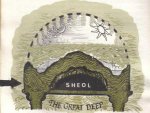(Not to get confused with the Mormon theology of 3 sections of Heaven)
Genesis 1 New International Version (NIV)
The Beginning
1 In the beginning God created the
heavens and the earth.
In my research I have not thought much on the idea that Satan even though being casted out of Heaven, in many different times still has dealings with God in the Heavenly realm.
It came to my attention that Heavens is plural. The Hebrew word is shamayim and
im is the plural ending.
We know there is different realms of Hell. So there possibly is different realms of Heaven.
View attachment 206540
This was ancient Jewish understanding of the Heavenly and spirit realms. The physical world was the circle broken dotted line above the moon and sun. The open gaps was what they believed is how Angel's entered the physical realm. While sheol was the grave and the great deep was the realms of Hell.
Not really theologically set on a certain belief with Heavenly realms but it is a interesting concept.
I agree, it is an interesting concept. And the idea of multiple Heaven's isn't exclusive to the Judeo-Christian faith.
Since our faith is grounded in Judaism you might enjoy this. (I get criticized for posting links to non-bias sources. The reason I do this is so that we can all avail ourselves of the opportunity to learn more than we think we already know.)
Where does the idea of seven heavens come from? Is the idea of a seventh heaven biblical?
(excerpted)
Judaism's Seven Heavens
The Hebrew word for heaven,
shamayim, is only ever plural. Different traditions have different numbers of heavens; the Jewish mystical text, the Zohar, claims there are 390 heavens and 70,000 worlds. As science progresses, the understanding of the seven heavens is becoming less literal and more allegorical, as a description of how God interacts with His creation.
Mystical Judaism says followers can make their way through the heavens if they pass certain tests and know the names of the guardian angels. At each level, the mystic is allowed to receive particular wisdom. Some Jewish scholars say Paul's trip to the "third heaven" is an example (
2 Corinthians 12:2-4). Legend says when Moses went to Mt. Sinai, God opened up all the heavens and let the Israelites see in (
Exodus 19:10-11).
The characteristics of the seven heavens vary with source and have been discussed by the Rabbis of the Talmud for ages. The apocryphal book 2 Enoch (written, perhaps, shortly before the fall of the Temple in AD 70) gives a great amount of detail. But the book can't be a true account, since it was written nearly 4000 years after the biblical Enoch was taken by God. The story may have been adapted from Zoroastrianism.
Originally, 2 Enoch mentioned seven heavens; it was later changed to ten, possibly by the Eastern Orthodox Church in the 7th Century. What each of the heavens contain or represent vary depending with the teller. The story claims that Enoch walked the heavens with the angels, returned to earth and told his family, then was taken to heaven again (
Genesis 5:24). The heavens he visited were:
Vilon ("curtain"): a curtain which is rolled over the earth at nighttime to block the sun (
Isaiah 40:22); contains the atmosphere, minor stars, snow and dew; abode of Adam and Eve; governed by Gabriel; called
curtain or
veil because it veils or hides the other six levels; represented by the moon
Raqi'a/Raki'a ("expanse," "canopy"): possibly refers to the frozen canopy over the earth before the Flood (
Genesis 1:7-8;
Deuteronomy 11:11); Moses visited Paradise here to receive the Ten Commandments; fallen angels are imprisoned here for marrying human women (
Genesis 6:4); dwelling place of souls awaiting judgment including "men of renown," apostates, tyrants; called
expanse because it's where the sun and planets dwell (
Genesis 1:14,
17); represented by Mercury
Shehaquim/Shehaqim/Shehakim ("clouds"): Eden and Tree of Life, the mill that produces manna; also includes paradise and hell/hades (
Psalm 78:23-24); represented by Venus
Zebul ("habitation"): stratosphere, sun, moon, and "four great stars," including celestial mechanics; dwelling of the winds; called
habitation because it's where the New Jerusalem with its temple is (
Isaiah 63:15); represented by the sun
Ma'on ("refuge"): home to "Grigori" — fallen angels who mourn for their brothers in Raqi'a; hell/Gehenna; Michael or possibly Samael presides; filled with ministering angels who sing by night; called
refuge because it's where most of the angels reside; represented by Mars
Makhon/Machon/Makon ("city," "established place"): home for angels in charge of nature's cycles and good governing systems of the world; angels who write men's actions in books; governed by Samael, a dark servant of God; storage place of rain, snow, and hail (
Deuteronomy 28:12); called
city because it's where the City of Angels resides; represented by Jupiter
Araboth/Aravot ("deserts"): also known as the 10th heaven; Throne of Glory and God dwell here as well as unborn human souls, Seraphim, Cherubim, justice, righteousness, souls of the righteous, and ineffable light (
Psalm 68:5); called
desert because it has no moisture and no air; God also said to be above the seventh heaven; represented by Saturn
It's possible that Judaism's belief in multiple heavens could have been influenced by Zoroastrianism, but it's unclear how Zoroastrianism influenced Judaism — or if it was the other way around. Jews taken to Babylon in exile who did not return to Jerusalem would have been exposed to Zoroastrian laymen. It's possible Judaism got the idea of multiple heavens at this time. In fact, the word "paradise," one of many words used to reflect heaven, comes from the Persian for "enclosed park or garden."
Judaism might also have been influenced by the ancient Babylonian tales. Perhaps Abraham brought the mythology with him from Ur. The parallel affiliation with celestial bodies indicates a closer relation to Babylonian stories than Zoroastrian.


1
